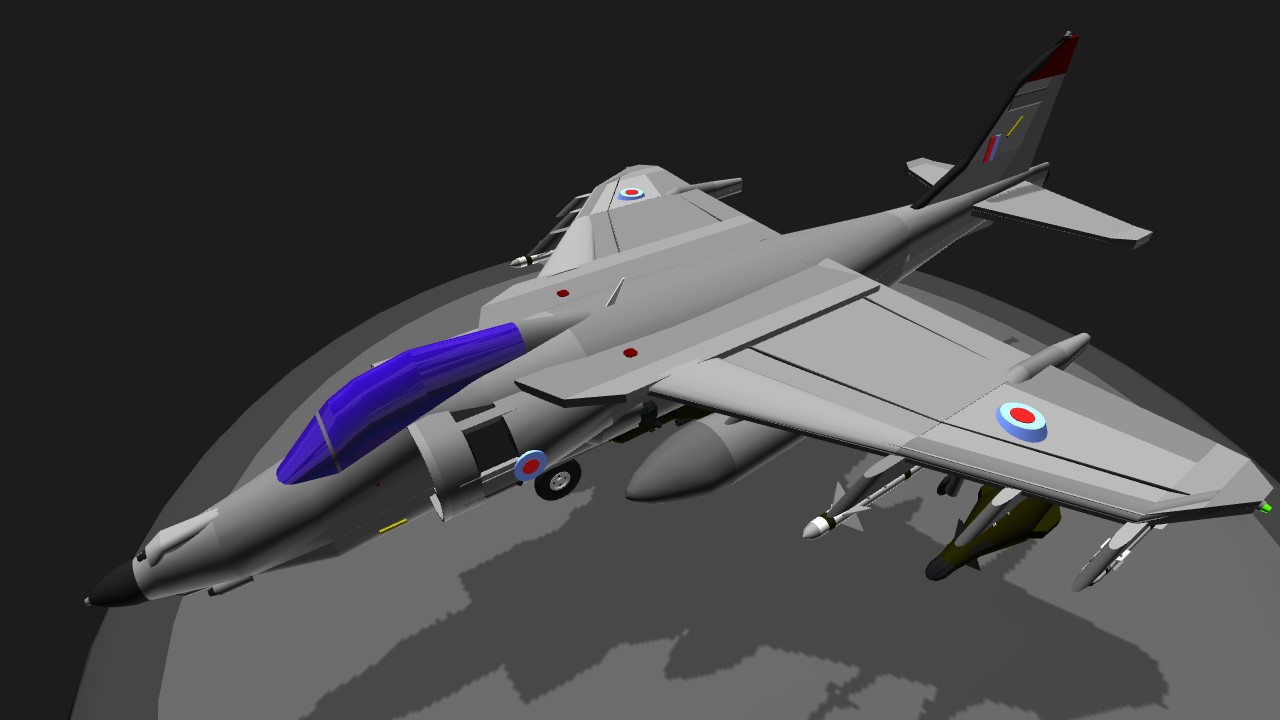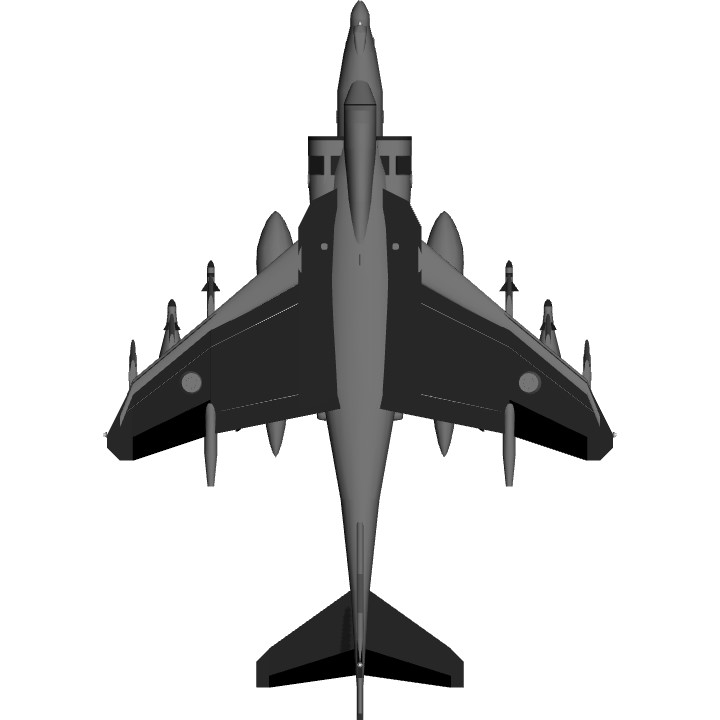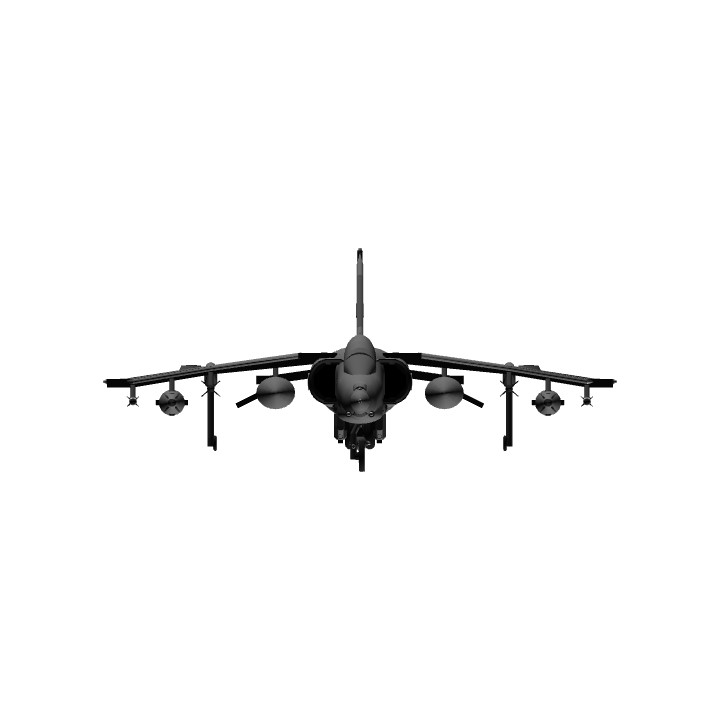From the all knowing all seeing eye of Sauronesque wikipedia;
The British Aerospace Harrier II was a second-generation vertical/short takeoff and landing (V/STOL) jet aircraft used previously by the Royal Air Force (RAF) and, between 2006 and 2010, the Royal Navy (RN). The aircraft was the latest development of the Harrier Jump Jet family, and was derived from the McDonnell Douglas AV-8B Harrier II. Initial deliveries of the Harrier II were designated in service as Harrier GR5; subsequently upgraded airframes were redesignated accordingly as GR7 and GR9.
Under the Joint Force Harrier organisation, both the RAF and RN operated the Harrier II, including routine operational deployments on board the navy's Invincible class aircraft carriers. The Harrier II participated in numerous conflicts, making significant contributions in combat theatres such as Kosovo, Iraq, and Afghanistan. The type's main function was as a platform for air interdiction and close air support missions; the Harrier II was also used for presence projection and reconnaissance duties. The Harrier II served alongside the Sea Harrier in Joint Force Harrier.
In December 2010, budgetary pressures led to the early retirement of all Harrier IIs from service, at which point it was the last of the Harrier derivatives remaining in British service. The decision to retire was controversial as there was no immediate fixed-wing replacement in its role or fixed-wing carrier-capable aircraft left in service; in the long term the Harrier II is to be replaced by the Lockheed Martin F-35 Lightning II. Which I will believe when I see it...
Anyway - the controls;
*NOTE! The throttle position will depend on the load out - now that the Harrier has gained 5 stores points, you can load her with all sorts of interesting explosives. The % figures given here are ballpark - ish figures, as it were.
AG1 - Unlock / Lock thrust vectoring nozzles
AG2 - Unlock / Lock nose and wingtip landing gear
AG3 - Arm cannons
AG4 - Lights
AG5 - Ditch inner stores,
AG6 - Ditch mid wing stores*
(note! stores points in front of the landing gear are for a2a only and cannot be ditched)
* NOTE that the "modern" looking bombs on the mid wing stores points are dumb fire - you need to jettison them with AG6.
AG7 - Ditch outer stores
AG8 - VTOL stability assist system on / off
So - VTOL take off procedure goes like this;
1. Ensure AG 1 and AG8 are active.
2. Using the vtol slider, set the nozzles perpendicular to the ground (note that this bird has a definite nose up stance on the ground)
3. Throttle to 35-40%
4. You are now taking off. Vertically! Use yaw / roll / trim to keep on top of yaw / roll and pitch attitude)
5. Use trim slider to correct pitch and if hovering to stay level
6. Set vtol slider to neutral.
7. Deactivate AG1
8. Activate AG2
9. Set vtol full down to retract gear. Also activate regular landing gear control to retract main gear.
10. Deactivate AG2 and set vtol to neutral
11. Activate AG1
By now you shoudl be hovering at 2000,ft with the gear up.
Now - time to transition to conventional flight! This is actually quite easy.
Following on form step 11 above - gradually move the vtol slider down to rotate the thrust nozzles, whilst using trim to correct the pitch. Once you are at around 180 - 200 mph with the thrust nozzles fully rotated aft, just deactivate AG1 and AG8 - now you are flying. Really flying.
Landing - For conventional landing it shoudl be as simple as activating AG2, setting VTOL to neutral and hitting "gear" to lower the main gear. Then land her gently as you would any other conventional jet.
For vertical landing, you need to;
1. Set throttle to 30-35% & activate AG1 and AG8
2. Use thrust nozzles (vtol slider) to brake down to 30 -50 mph
3. Set vtol to neutral
4. Now you are hovering again.
5. Deactivate AG1, Activate AG2. This shoudl drop the nose and wingtip gear - hit "gear" to drop the main gear.
6. Deactivate AG2. Activate AG1.
7. Use pitch slider to control pitch and also any fore / aft creep (i.e. keep her hovering over the target. (vtol slider can also be used)
8. Set throttle to 50% and begin descent.
9. Good luck!
Now go blow stuff up. Vertically! More!
Sea Harrier next...
Specifications
Spotlights
- ChiChiWerx 8.2 years ago
General Characteristics
- Predecessor Hawker Siddeley Harrier GR.3
- Created On iOS
- Wingspan 32.4ft (9.9m)
- Length 45.5ft (13.9m)
- Height 14.1ft (4.3m)
- Empty Weight 12,912lbs (5,857kg)
- Loaded Weight 18,292lbs (8,297kg)
Performance
- Power/Weight Ratio 2.948
- Wing Loading 24.4lbs/ft2 (118.9kg/m2)
- Wing Area 751.1ft2 (69.8m2)
- Drag Points 8074
Parts
- Number of Parts 272
- Control Surfaces 10
- Performance Cost 965







Running all the way... ;-)@Tang0five
Very nice! I'd love to see a hypothetical upgrade. One where the Mod and gov had a bit of sense....
@GhostHTX it would certainly be fun, I need to figure out multiplayer, sigh....
Im not totally sure how multi player works either, but that would be great fun. Although... Scooter vs Shar... Your flight plan would look like;
1. Take off
2. Gear up
3. Explode...
That said, youre an actual pilot and Im just some guy... might be a fun fight?@ChiChiWerx
@ChiChiWerx Ive been working with a download called the "XML cheat bench". It is a collection of parts that you cant get without mods, weightless parts, no clip parts and very very small bits etc. But 1.7 on iOS is going to rock, no doubt.
You might want to wait until 1.7 releases on iOS...it should give your platform nudge and fine adjustment.
@GhostHTX I have no idea how to do multiplayer, but it would be awesome if we did a Falklands role play...you with your FRS.1, me with my Skyhawk!
I know! Sea Harrier FRS.1 next!! @ChiChiWerx
This thing is getting more and more complicated through the years!